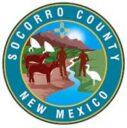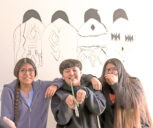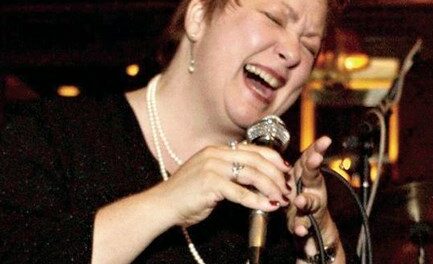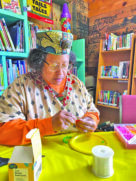
Courtney said that she began celebrating Kwanzaa over 30 years ago, when her children were young because she wanted them to have an understanding of their distant African heritage.
“I wanted my kids to feel proud of themselves, and of their extended family members. I hoped that our family bond would be strengthened and that my kids would find Kwanzaa meaningful,” Courtney said.
“This was the sixth annual Kwanzaa presentation,” said Yvonne Magener, Magdalena Public Librarian. “Cricket is a wonderful volunteer and she’s always ready to help so she’s a great asset to the community.”
Courtney shared one her favorite memories of Kwanzaa when her nephew, Andrew, age 10, was visiting her.
“He created a paper sculpture that he called ‘Kwanzaa Klaus’. I cherish this gift and bring it out each year to include in my Kwanzaa display. I also have a paper mkeke (mat) that my daughter made for me around the same time and keep it with my Kwanza kit,” Courtney said.
Kwanzaa is a non-religious, seven-day holiday created in 1966 by Professor Dr. Maulana Karenga to bring together, renew and energize Black/African Americans. According to Courtney it was created as an opportunity for people to connect with their rich African cultural heritage. Karenga wanted black people to celebrate themselves and their contributions to their communities and greater society.
She clarified that Kwanzaa is not a religious holiday and can be celebrated by people of many faiths, as well as those who do not embrace any religion. While Kwanzaa was created for African Americans, none of Kwanzaa’s seven principles calls for nationalism or separatism, said Courtney.
“The most important things that people in our community should know about Kwanzaa is that it is a holiday that has been celebrated for over five decades and that it promotes family cooperation and participation as well as uniting and strengthening our communities,” Courtney said, “I find that the principles of Kwanzaa pertinent to any community in which I have lived.”
In her presentation she shared the seven principles, or Nguzo Saba, which are a set of ideals created by Dr. Maulana Karenga. Each day of Kwanzaa emphasizes a different principle.
Unity: Umoja (oo–MO–jah) To strive for and maintain unity in the family, community, nation, and race.
Self-determination: Kujichagulia (koo–gee–cha–goo–LEE–yah) To define ourselves, name ourselves, create for ourselves, and speak for ourselves.
Collective Work and Responsibility: Ujima (oo–GEE–mah) To build and maintain our community together and make our brothers’ and sisters’ problems, our problems and to solve them together.
Cooperative Economics: Ujamaa (oo–JAH–mah) To build and maintain our own stores, shops, and other businesses and to profit from them together.
Purpose: Nia (nee–YAH) To make our collective vocation the building and developing of our community in order to restore our people to their traditional greatness.
Creativity: Kuumba (koo–OOM–bah) To do always as much as we can, in the way we can, in order to leave our community more beautiful and beneficial than we inherited it.
Faith: Imani (ee–MAH–nee) To believe with all our heart in our people, our parents, our teachers, our leaders, and the righteousness and victory of our struggle.
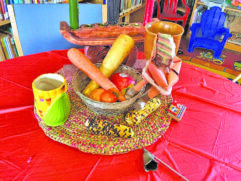
Mazao: Crops Fruits, nuts, and vegetables.
Mkeka: Place Mat Symbolizes the historical and traditional foundation.
Vibunzi: Ear of Corn Corn represents fertility and the future. One ear of corn for each child is placed on the Mkeke.
Mishumaa Saba: The Seven Candles. The black candle represents the people and Africa. The three green candles represent growth, the earth and the future, and the three red candles represent the struggle for self-determination and freedom by the people.
Kinara: Candle Holder The kinara is the center of the Kwanzaa setting and represents the original stalk from which we came: our ancestry.
Kikombe Cha Umoja: The Unity Cup A special cup that is used to perform the libation (tambiko) ritual during the Karamu feast on the sixth day of Kwanzaa. The libation honors our ancestors and those who have gone before us.
Zawadi: Gifts These gifts, often handmade, promote self-determination, purpose, and creativity. Other gifts are educational in nature. Children are the recipients of Zawadi, generally.
“I think a community is enriched by promoting creativity and faith in each other and that we can improve our locality by identifying problems and implementing solutions together,” Coutney said.
Courtney has been doing the Kwanzaa presentation in Magdalena since December 2016.

